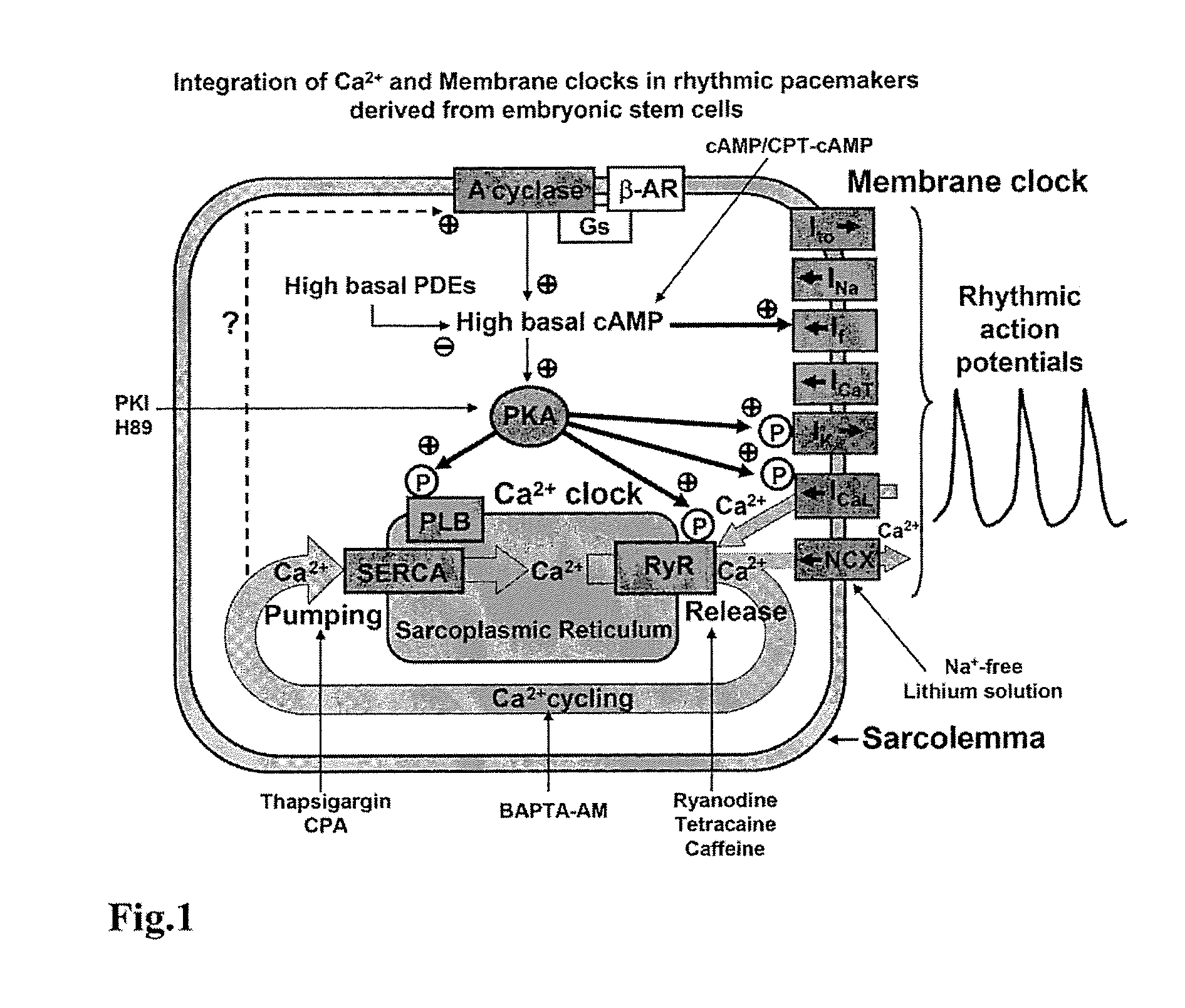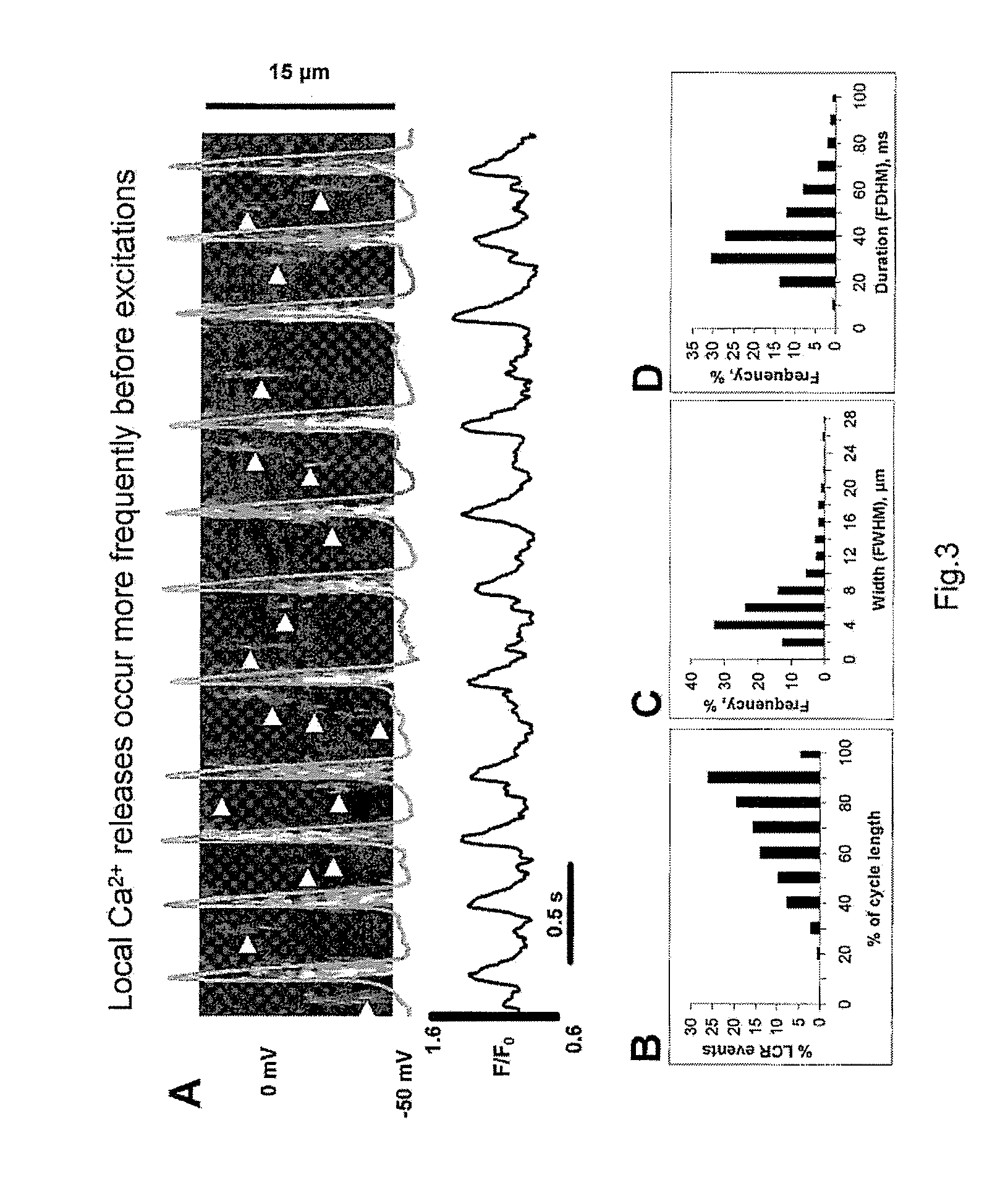Engineered biological pacemakers
a technology of biological pacemakers and implantable pacemakers, applied in the field of biological pacemakers, can solve the problems of limited lifetime, implantable pacemakers may not directly respond to physiological signals, and limitations, and achieve the effect of treating or preventing arrhythmias
- Summary
- Abstract
- Description
- Claims
- Application Information
AI Technical Summary
Problems solved by technology
Method used
Image
Examples
example 1
Culture and Differentiation of ES Cells
[0073]Only late-stage differentiated ESCs (7+9 to 14 days) were used. These cells possess both major ion channels (ICaL, If, INa, Ito, IK)(4), exchangers (NCX), and Ca2+ cycling proteins (RyR2, SERCA2A, calcequestrin, and phospholamban). Late-stage ESCs have been successfully used as temporary biological pacemakers in whole animal model experiments.
[0074]Mouse ES cells of line R1 were differentiated into cardiac cells using the “hanging drop” technique. ESCs were isolated from in vitro-grown embryoid bodies by microdissection followed by collagenase treatment. ES cells of line R1 were cultivated on inactivated feeder layer of primary mouse embryonic fibroblasts on gelatin (0.1%)-coated petri dishes (Fischerbrand) in DMEM supplemented with 15% heat-inactivated fetal bovine serum (FBS), 2 mmol / L L-glutamine, 0.1 mmol / L γ-mercaptoethanol, non-essential amino acids (NEAA, stock solution diluted 1:100), penicillin-streptomycin (stock solution dilute...
example 2
[0075]ESCs differentiated in vitro for 9 to 20 days after plating of 7 days old embryoid bodies were studied during continuous superfusion with solution containing in mmol / L: 140 NaCl, 5.4 KCl, 5 HEPES, 2 MgCl2, 1.8 CaCl2, 10 glucose, (pH adjusted to 7.4 with NaOH). Selection of the cells for patch-clamp technique was based on spontaneous beating. Action potentials were measured at physiological temperature (35±2° C.) with standard current-clamp technique (Axopatch 200, Axon Instruments, Foster City, Calif., USA), pCLAMP7 software was used for data acquisition and analysis (Axon Instruments). Perforated patch-clamp technique was performed with β-escin added to the electrode solution. Patch pipette solution contained in mmol / L: 120 K-gluconate, 5 NaCl, 5 Mg-ATP, 5 HEPES, 20 KCl, 3 Na2ATP (pH adjusted to 7.2 with NaOH). Recording of L-type Ca2+ current (ICaL) simultaneously with Ca2+ signal imaging (see Example 3) were performed under whole cell voltage clamp. Patch p...
example 3
Ca2+ Imaging in Intact Cells
[0076]Confocal imaging of Ca2+ release in ESCs was performed by placing cells on the stage of a inverted confocal microscope and loaded for 15 min with 10 μmol / L fluo-4 AM in dimethyl sulfoxide (Molecular Probes, Eugene, Oreg.) in perforated patch experiments. In whole cell configuration, fluo-4 was added directly to the pipette solution.
PUM
| Property | Measurement | Unit |
|---|---|---|
| membrane potential | aaaaa | aaaaa |
| volumes | aaaaa | aaaaa |
| volumes | aaaaa | aaaaa |
Abstract
Description
Claims
Application Information
 Login to View More
Login to View More - R&D
- Intellectual Property
- Life Sciences
- Materials
- Tech Scout
- Unparalleled Data Quality
- Higher Quality Content
- 60% Fewer Hallucinations
Browse by: Latest US Patents, China's latest patents, Technical Efficacy Thesaurus, Application Domain, Technology Topic, Popular Technical Reports.
© 2025 PatSnap. All rights reserved.Legal|Privacy policy|Modern Slavery Act Transparency Statement|Sitemap|About US| Contact US: help@patsnap.com



